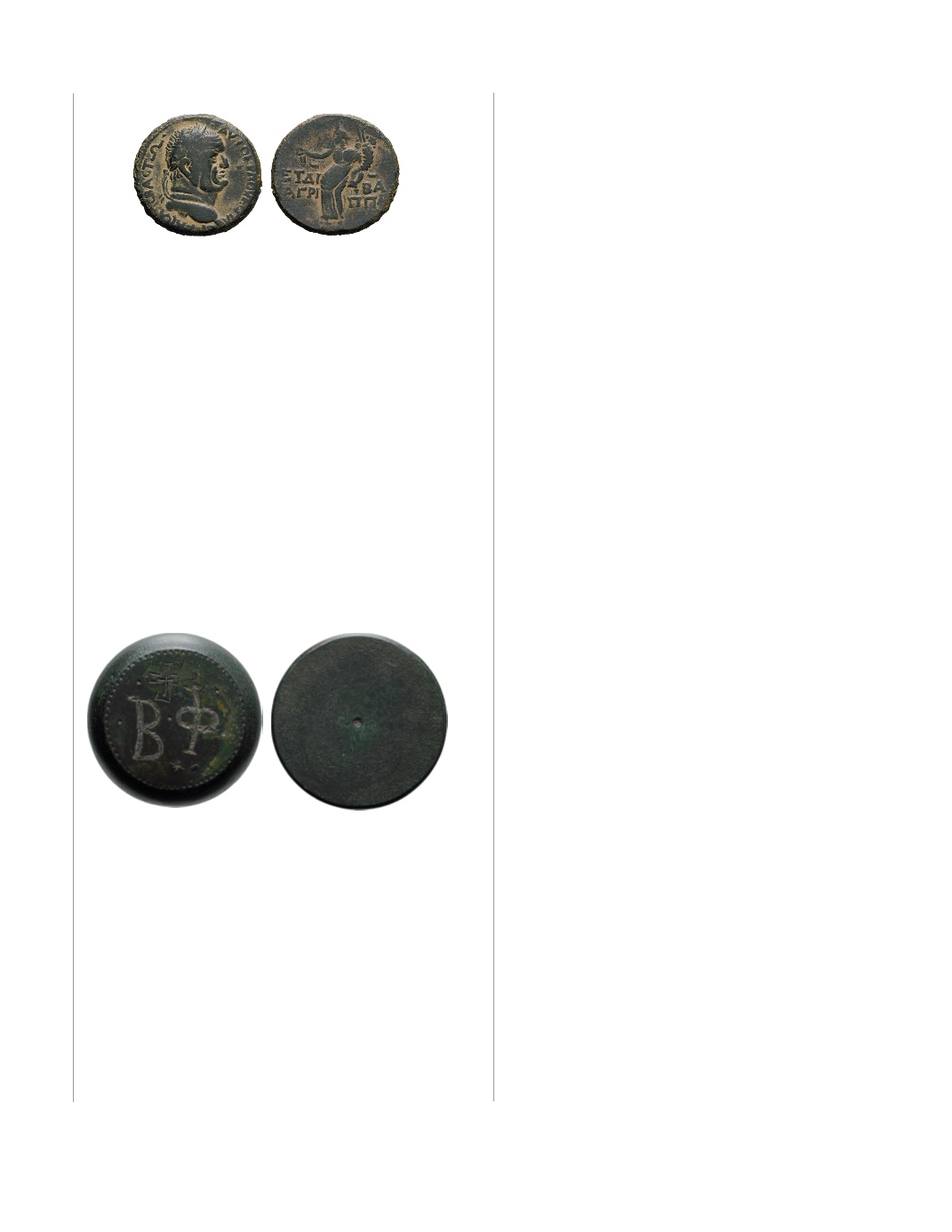

87
376.
Agrippa II for Vespasian.
69-79 AD. AE 28,
18.26g (11h). Agrippa’s year 14 = 73/4 AD. Obv:
AVTOKPA OVECΠA - CI KAICAPI CBACTΩ.
(sic) Head of Vespasian laureate right. Rx: ET ΔI -
BA / AΓPI - ΠΠA (“Year 14 of King Agrippa”) in
two lines across field, Tyche standing left holding
two wheat ears and cornucopia. RPC 2243 (5 spec.).
Hendin 1301 corr. Sofaer Coll. 184, pl. 214. Bold
Fine
$700
From the Bill Behnen Collection, exception-
ally not reign of Decius; acquired from Holyland
Numismatics on an unrecorded date.
E omitted from CEBACTΩ in obverse legend by
engraver’s error. Very rare with this type and date.
RPC lists just five examples, and reports that all five
come from the same obverse die, illustrated on pl.
97. Two additional specimens, ours and Sofaer 184,
were also struck from that same obverse die
.
377.
Byzantine Round Commercial Bronze
Weight.
AE 4-Ounces (Triens) or 24-Nomismata,
105.00g. 6th-7th cent. AD. Obv: Engraved letters
BΦ with inlaid silver, engraved cross above and
eight-pointed star below; all within dotted border.
Rx: Blank apart from central hole. Unpublished in
the standard references. Good VF
$750
From the Bill Behnen Collection, purchased from
Alteir Corp. in April 2012
.
The letters BΦ on the obverse of our piece are
presumably private ownership initials. For compa-
rable Byzantine 4-ounce weights which were how-
ever government issues, see S. Bendall, Byzantine
Weights, An Introduction (1996), 131; J. Forien de
Rochesnard, Album des poids antiques III, p. 57; M.
Campagnolo, M. Weber, and F. Weber, Poids roma-
no-byzantins en alliage cuivreux (2015), 37-8
.
A Large Collection of Roman Provincial Coins
Struck at Alexandria in Egypt, Donated to the
Art Institute of Chicago in 1978-1984 by Robert
L. Grover, and Containing Many Pieces Deriving
from the Giovanni Dattari Collection, the Most
Complete Collection of Alexandrian Coins Ever
Assembled.
Each coin, even those in the large lots, is
accompanied by a square ticket, 1 5/8” (41 mm)
wide and high, on which the following information
is recorded: the Art Institute’s acquisition
number, always beginning with the year of
donation, between 1978 and 1984; a brief
description of the coin, with its date (regnal year)
but not transcribing its obverse legend; one or two
references to standard catalogues, usually BMC
and Dattari; and, occasionally, a note of the coin’s
pedigree, “ex Dattari Collection”. Quite a few of
the tickets also cite more recent reference works,
added by Harlan Berk’s cataloguer in preparing the
coins for auction; for example Angelo Geissen’s
Cologne catalogue (Cologne), Roman Provincial
Coinage (RPC), and the volume of Dattari rubbings,
with introductory material and some cataloguing by
Adriano Savio (Dattari-Savio).
It is curious that of the 139 coins stated by their
tickets to derive from the Dattari Collection, about
half could indeed also be located in the Dattari-
Savio volume of rubbings, but the other half could
not be found there. Since it seems unlikely that
either the donor Robert L. Grover or the dealers
from whom he bought were fabricating Dattari
pedigrees, it would appear that the Dattari
Collection included quite a few coins that are not
illustrated in the published volume of rubbings,
presumably because they were acquired after those
rubbings had been made.
Perhaps thirty or forty additional coins were
noted by the cataloguer to derive from the Dattari
Collection, because rubbings of them are shown in
Dattari-Savio, though this pedigree had not been
recorded on their tickets. It seems likely that Dattari
pedigrees remain to be observed for some other
coins in the collection too, since the cataloguer did
not check many of the commoner coins against the
rubbings.


















